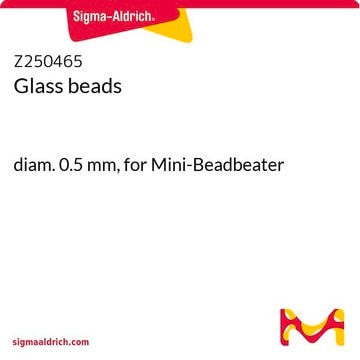G9143
Glass beads, unwashed
212-300 μm (50-70 U.S. sieve)
Synonym(s):
Raw Glass Beads
Sign Into View Organizational & Contract Pricing
All Photos(4)
About This Item
UNSPSC Code:
41100000
NACRES:
NB.22
Recommended Products
particle size
212-300 μm (50-70 U.S. sieve)
Application
Unwashed glass beads have been used for the extraction of DNA from Fonsecaea sp.
Storage Class Code
11 - Combustible Solids
WGK
WGK 3
Flash Point(F)
Not applicable
Flash Point(C)
Not applicable
Personal Protective Equipment
dust mask type N95 (US), Eyeshields, Gloves
Certificates of Analysis (COA)
Search for Certificates of Analysis (COA) by entering the products Lot/Batch Number. Lot and Batch Numbers can be found on a product’s label following the words ‘Lot’ or ‘Batch’.
Already Own This Product?
Find documentation for the products that you have recently purchased in the Document Library.
Customers Also Viewed
Mohammad Javad Najafzadeh et al.
Emerging infectious diseases, 17(3), 464-469 (2011-03-12)
To assess population diversities among 81 strains of fungi in the genus Fonsecaea that had been identified down to species level, we applied amplified fragment-length polymorphism (AFLP) technology and sequenced the internal transcribed spacer regions and the partial cell division
Renata R Gomes et al.
PLoS neglected tropical diseases, 10(11), e0005102-e0005102 (2016-11-29)
The human mutilating disease chromoblastomycosis is caused by melanized members of the order Chaetothyriales. To assess population diversity among 123 clinical strains of agents of the disease in Brazil we applied sequencing of the rDNA internal transcribed spacer region, and
Fusarium species causing eumycetoma: Report of two cases and comprehensive review of the literature.
Abdullah M S Al-Hatmi et al.
Mycoses, 60(3), 204-212 (2016-12-09)
Recently, mycetoma was added to the World Health Organization's list of neglected tropical disease priorities. Fusarium as a genus has been reported to cause eumycetoma, but little is known about the species involved in this infection and their identification. In
M J Najafzadeh et al.
Mycopathologia, 183(4), 669-677 (2018-03-06)
The black yeast genus Exophiala includes numerous potential opportunistic species that potentially cause systematic and disseminated infections in immunocompetent individuals. Species causing systemic disease have ability to grow at 37-40 °C, while others consistently lack thermotolerance and are involved in diseases
M J Najafzadeh et al.
Microbial pathogenesis, 125, 43-47 (2018-09-09)
Chromoblastomycosis is one of the most prevalent implantation fungal infections caused by melanized fungi, affecting individuals with certain risk factors with high morbidity due to its recalcitrant nature. It is difficult to identify the etiological agents and thus a suitable
Our team of scientists has experience in all areas of research including Life Science, Material Science, Chemical Synthesis, Chromatography, Analytical and many others.
Contact Technical Service












